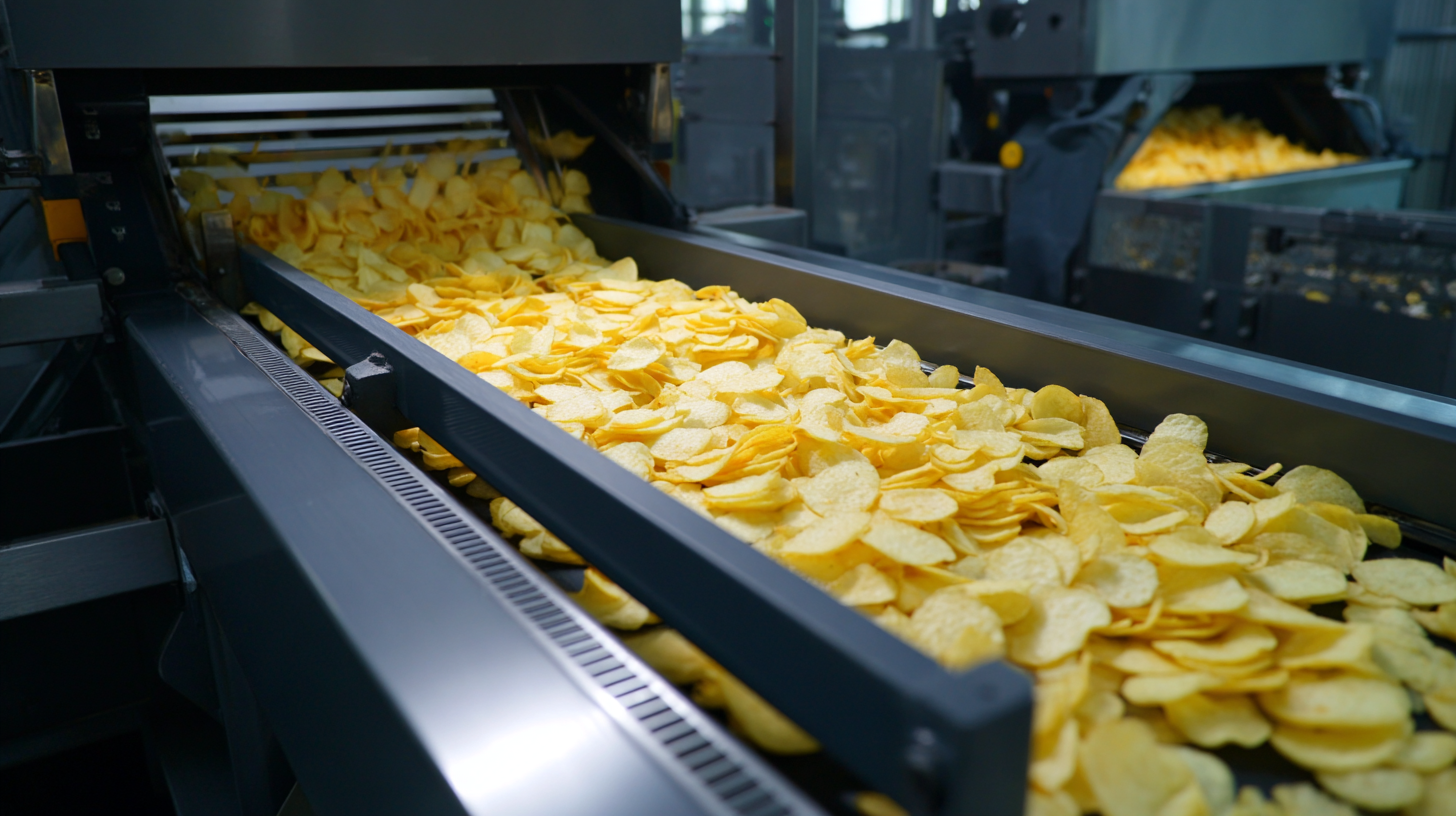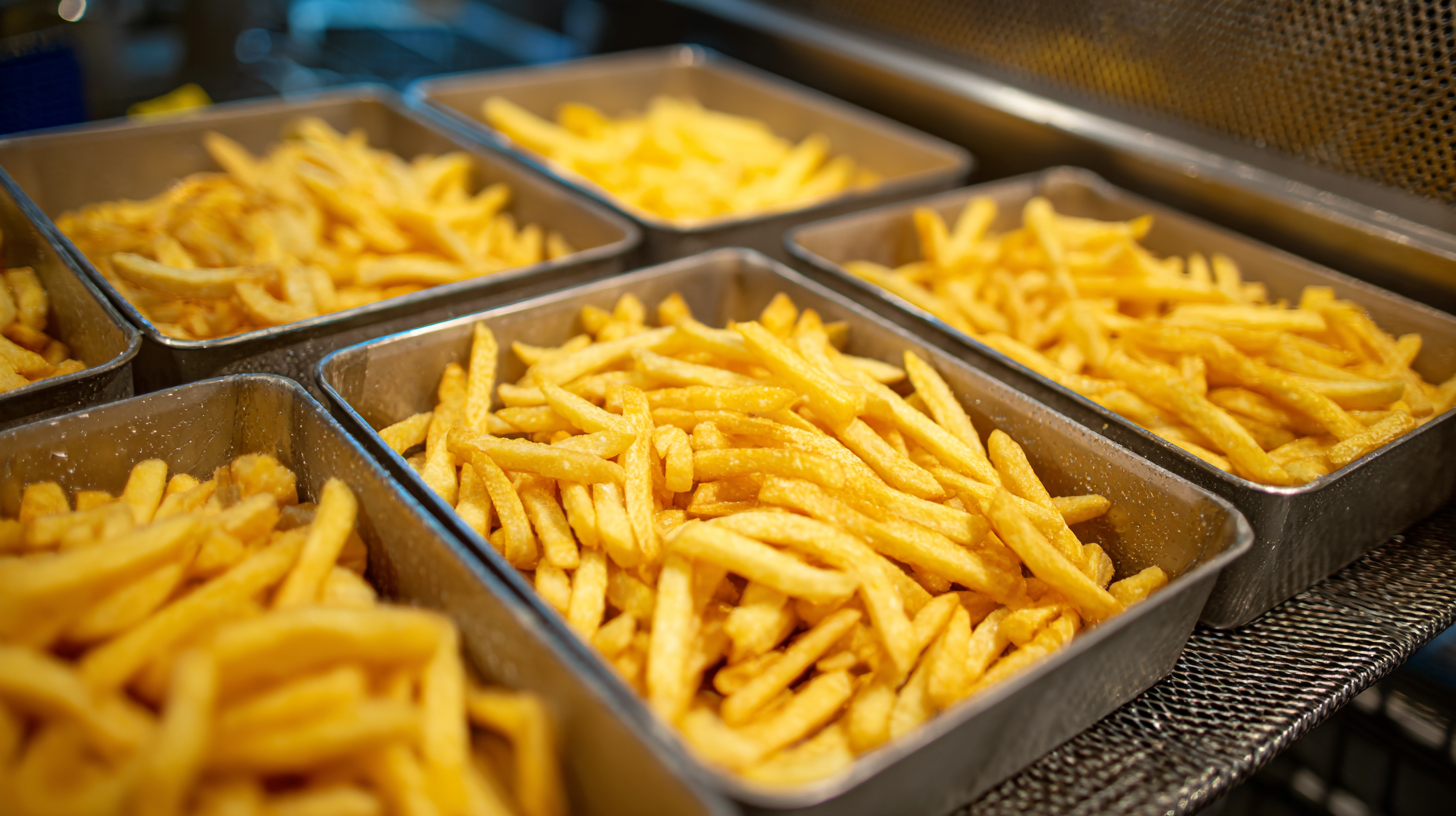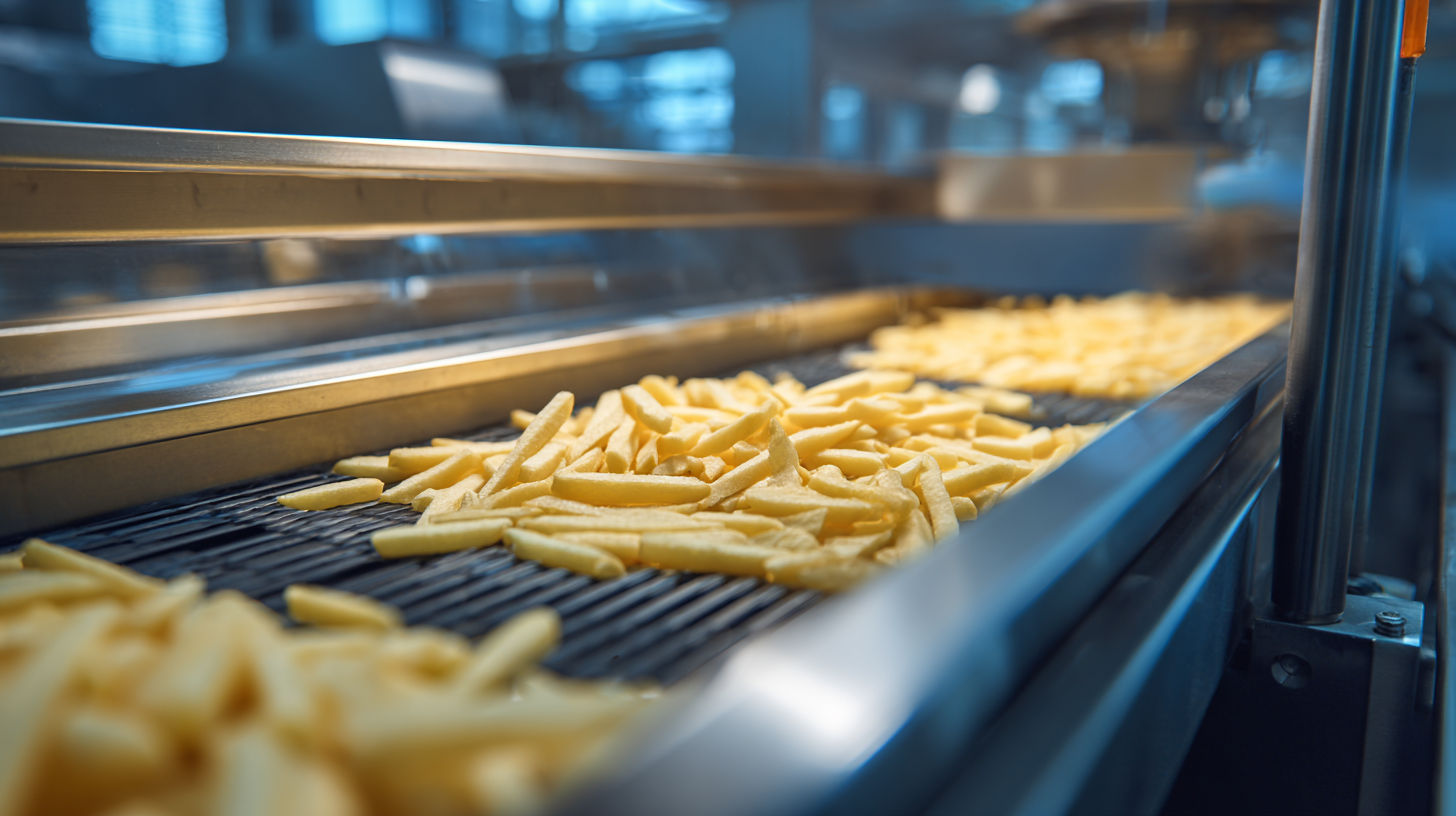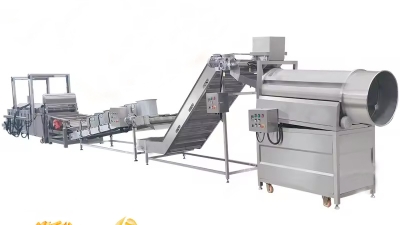The Future of Efficient Frozen French Fries Production Technology
Table of Contents
- Innovative Techniques for Enhancing Frozen French Fries Production Efficiency
- Key Ingredients and Their Impact on Fry Quality and Efficiency
- Automation in French Fries Production: Streamlining Processes for Better Output
- Sustainability Practices in Frozen French Fries Manufacturing
- Adapting to Consumer Trends: Healthier and More Convenient Frozen Fries Options
- Future Technologies in Frozen Food Production: What to Expect Next
- Optimizing Your Snack Production: The Advantages of an Automatic Fried Potato Chips Machine for Frozen French Fries
- FAQS
- Conclusion
- Related Posts
Lately, there's been a huge spike in the global demand for Frozen French Fries. I mean, estimates say the market might hit around USD 47 billion by 2027! People are really into convenience foods these days, and snack items are more popular than ever. Because of that, companies are looking for better, more efficient ways to make frozen fries — especially in production lines. Shandong Kexinde Machinery Technology Co., Ltd. is definitely stepping up in this space. They're all about innovating and improving their machinery to get better yields and higher quality, all while cutting down on energy use. By adopting new tech like digital monitoring and automation, food producers can really streamline their processes, keep up with the increasing demand, and stay competitive and sustainable in the frozen food world. It’s pretty exciting to see how technology is shaping the future of snack foods like these!

Innovative Techniques for Enhancing Frozen French Fries Production Efficiency
You know, as more and more people around the world crave frozen French fries, the food industry is really stepping up with some cool new techniques to keep up. They've started using smarter automation and robots in processing plants — things like automated peeling, slicing, and frying. It’s pretty awesome because it speeds things up a lot, and the best part is, it keeps the quality consistent. Plus, it cuts down on waste and saves on labor costs. It’s like they’re making it easier to grow bigger and better, all while keeping an eye on quality through real-time data, which is pretty neat.
Another exciting thing going on is new freezing methods, like flash freezing and cryogenic freezing. These actually cut down the freezing time big time, which helps keep the fries tasting great and preserves their texture longer. Not to mention, it also uses less energy and helps get products to shelves faster. That means companies can react quicker to what customers want. And they’re also focusing on being more eco-friendly — using energy-efficient machines and reducing waste — so they’re not just making delicious fries but also doing their part for the planet.
The Future of Efficient Frozen French Fries Production Technology
| Production Technique | Efficiency Improvement (%) | Energy Consumption (kWh/ton) | Production Yield (%) | Waste Reduction (%) |
|---|---|---|---|---|
| Cryogenic Freezing | 30 | 150 | 95 | 20 |
| Continuous Frying Technology | 25 | 180 | 90 | 15 |
| High-Pressure Processing | 20 | 140 | 92 | 10 |
| Infrared Heating | 15 | 130 | 88 | 12 |
| Automation and AI Integration | 35 | 160 | 93 | 18 |
Key Ingredients and Their Impact on Fry Quality and Efficiency
Making really good frozen French fries all comes down to using the right ingredients. According to a report from the Food and Agriculture Organization, the kind of potatoes you pick makes all the difference—that is, those with a high starch content (around 20% or more) tend to produce fries that are crisper and tastier. Plus, new machinery that improves peeling, cutting, and frying can make a huge difference in texture and flavor, making your fries more appealing to folks craving that perfect bite.
 Oh, and technologies like infrared frying or vacuum frying? They've actually proven to boost fry quality and efficiency quite a bit. Some research shows these methods can cut down frying times by up to 40%, all while keeping the natural flavor and nutrients of the potatoes intact. Here at Shandong Kexinde Machinery Technology Co., Ltd., we’re all about designing cutting-edge equipment that stays ahead of industry trends, so producers can keep their standards high and production smooth.
Oh, and technologies like infrared frying or vacuum frying? They've actually proven to boost fry quality and efficiency quite a bit. Some research shows these methods can cut down frying times by up to 40%, all while keeping the natural flavor and nutrients of the potatoes intact. Here at Shandong Kexinde Machinery Technology Co., Ltd., we’re all about designing cutting-edge equipment that stays ahead of industry trends, so producers can keep their standards high and production smooth.
A little tip if you're choosing potatoes—go for varieties like Russet or Ranger. They've been bred specially for frying, which helps get you that perfect crunch. And if you’re serious about efficiency, investing in all-in-one systems that handle multiple steps of the process can really save time and improve the quality of your fries at the same time.
Automation in French Fries Production: Streamlining Processes for Better Output
You know, these days, automation is really shaking up how frozen French fries are made, and honestly, it’s pretty impressive. The whole process is becoming way more efficient, and the quality of the fries is just getting better and better. Thanks to cool tech like robots and AI, things like handling potatoes, frying, and packaging are all getting streamlined. Now, these automated systems can run the entire production line with laser-sharp accuracy — meaning fewer mistakes and fries that stay consistently the same size and texture.
It’s a big win because it cuts down on labor costs and speeds things up, so companies can keep up with the huge worldwide demand for frozen fries.
And as these systems get smarter, they’re also adding real-time monitoring and data analysis, which helps optimize the whole operation. For example, sensors can check the quality of potatoes before they even go into the process, making sure only top-notch ingredients are used. Plus, manufacturers can tweak frying times and temps on the fly, thanks to advanced controls — so every batch of fries comes out perfectly cooked, every single time.
Honestly, this shift isn’t just about saving money; it’s about creating a better product that meets the expectations of health-conscious folks and fast-food joints alike. And as the tech keeps improving, the future of frozen French fries looks pretty darn exciting!
Sustainability Practices in Frozen French Fries Manufacturing
So, you know how everyone’s pretty much obsessed with frozen French fries these days? Well, manufacturers are really starting to focus on being more eco-friendly to cut down on environmental impacts. Since this industry exports huge amounts of frozen potatoes all over the world, it’s more important than ever to find smarter ways to save resources and cut back on waste. For example, some of the top industry reports are showing that farming methods that are better for the planet can actually boost crop yields while also lowering carbon emissions from the whole process.
One key effort that’s gaining momentum is partnering up with local farmers. Not only does this help support local communities, but it also cuts down on the emissions caused by transporting ingredients over long distances. When brands work closely with farmers, they can offer fresher ingredients, which really makes a difference in the final product.
Here are some tips for going green:
- Smart Water Use : Use high-tech irrigation systems that save water but still keep the crops happy.
- Renewable Energy : Switch to solar or wind power for your plants to cut back on fossil fuels.
- Cut Down on Packaging Waste : Look into eco-friendly packaging that can be recycled or composted—kind of like closing the loop in a circular economy.
If manufacturers actually focus on these practices, they could really help make the frozen French fries biz more sustainable. And honestly, that’s good news for the planet and future generations. Let’s keep pushing for a greener future—one fry at a time!
Adapting to Consumer Trends: Healthier and More Convenient Frozen Fries Options
You know, the frozen French fries market is changing pretty fast these days. People are really beginning to look for healthier, more convenient snack options, and that’s definitely showing in what they buy. It’s not just about great taste anymore—more folks are paying attention to their health too. So, brands are getting creative with new processing methods that cut down on fat but still keep the fries tasty and nutritious. For example, air frying tech is really catching on, letting folks enjoy that crispy crunch with way less oil. Pretty cool, right?
And let’s not forget how much people value convenience. Life’s busy, and nobody wants to spend forever making snacks. That’s why you see brands coming out with pre-seasoned, ready-to-bake fries that you can throw in the oven in no time, no fuss. Plus, companies are expanding their ranges to include organic and gluten-free options, giving folks with specific diets more choices. So, it’s clear that as these trends develop, brands that really listen to what consumers want—healthier, easier, more versatile options—are going to have the best shot at standing out in this competitive game.
Overall, the landscape of frozen French fries is shifting, and staying aligned with what people are looking for is key if brands want to keep up and thrive down the line.
Future Technologies in Frozen Food Production: What to Expect Next
The global frozen foods market is really booming right now. In 2023, it's valued at around USD 284.2 billion, and experts expect it to grow to about USD 363.7 billion by 2028 — that's a solid compound annual growth rate of 5.1%. Basically, people are really leaning towards quick, convenient food options, but they still care about good quality. As tech gets better and better, there's a big push for more efficient ways to produce frozen foods—think frozen French fries, for example. These innovations in freezing technology are changing the game, helping manufacturers keep that fresh flavor while making it super easy for us to get what we want, whenever we want it.
And it’s not just the foods themselves that are growing — the packaging side of things is also expanding. In 2023, the frozen food packaging industry is expected to hit around USD 45.69 billion, with a steady annual growth rate of about 5.8% projected from 2024 through 2030. This just goes to show how much effort is going into better packaging solutions, ensuring that frozen goodies stay fresh and tasty all the way from the factory to your plate. Companies like Shandong Kexinde Machinery Technology are leading the charge, creating specialized equipment that makes the whole process smoother and helps produce top-notch frozen foods. The combo of cutting-edge tech and smarter packaging is pretty much essential to keep up with what today’s consumers are looking for in their frozen meals.

Optimizing Your Snack Production: The Advantages of an Automatic Fried Potato Chips Machine for Frozen French Fries
In the competitive world of snack production, optimizing your processes is crucial to maintaining efficiency and quality. One of the most significant advancements in this field is the automatic fried potato chips machine, designed to streamline the production of frozen French fries. With capacities ranging from 50 to 3000 kg per hour, these machines cater to various production scales, ensuring that businesses can meet increasing market demands without compromising on quality.
The automated production line encompasses every essential step, from washing and peeling to cutting, blanching, and frying. This all-in-one approach not only saves time but also enhances product consistency. For instance, the blanching process is crucial in retaining the fries' vibrant color and improving their texture. Moreover, the integrated freezing and packing features aid in preserving freshness and extending shelf life, making it a comprehensive solution for snack manufacturers.
Choosing between fully automated and semi-automated systems allows businesses to tailor their production lines according to their specific needs. With rich experience in the frozen French fries production line, investing in an automatic fried potato chips machine can significantly reduce labor costs while increasing output, proving to be an asset for any snack producer looking to optimize their operations.
FAQS
: The quality of raw potatoes, particularly those with high starch content (around 20% or more), is crucial for producing crispier and tastier fries.
Innovations in machinery for peeling, cutting, and frying can enhance the texture and flavor of fries, making them more appealing to consumers.
Techniques such as infrared frying and vacuum frying can reduce frying time by up to 40% while preserving the nutrients and taste of the potatoes.
Varieties like Russet or Ranger are specifically bred for frying and are recommended for processing frozen French fries.
There is a growing demand for healthier and more convenient frozen fries options, driven by health-conscious consumers and busy lifestyles.
Manufacturers are exploring processing methods that reduce fat content while enhancing nutritional value, such as air frying techniques that allow for crispy fries with less oil.
Brands are introducing pre-seasoned, ready-to-bake fries that promise quick preparation without sacrificing taste.
Yes, companies are expanding their product lines to include organic and gluten-free varieties to cater to consumers with specific dietary needs.
The rise of busy lifestyles has increased consumer demand for frozen options that are quick to prepare, driving brands to innovate in their offerings.
Adapting to evolving consumer trends is crucial for brands to remain competitive and thrive in the fast-changing frozen French fries market.
Conclusion
Looking into the future, the way we produce frozen French fries is about to change big time, thanks to some pretty innovative tech. These new techniques are all about making the whole process more efficient — honestly, who doesn’t want that? Plus, by adding key ingredients that boost fry quality, manufacturers can end up with a much better final product. Automation definitely plays a huge part here too, helping streamline things in the Frozen French Fries Production Line, which means better output and less money spent on labor.
And let’s not forget, with more focus on sustainability these days, food companies are shifting gears to meet what consumers want — healthier, more convenient options. Keeping up with those trends is pretty much essential if they want to stay ahead in this game. Looking ahead, I guess we can expect ongoing improvements in production tech, ensuring companies like Shandong Kexinde Machinery Technology Co., Ltd. keep their edge in the frozen food market — exciting times, right?
Related Posts
-

Ensuring Quality Standards in the Best Chips Fryer Machine Production for Global Buyers
-

15 Best Practices for Maximizing Your Tempura Nugget Line Efficiency
-

Unmatched Onion Ring Breading Machines from Leading Chinese Manufacturers for Global Excellence
-

Discover How Our Premier French Fries Maker is Setting the Standard for Global Supply Chains from China
-

Ultimate Checklist for Choosing Your Best Banana Chips Making Machine
-

Explore the Advanced Technical Specifications of the Best Fully Automatic Potato Chips Machine


